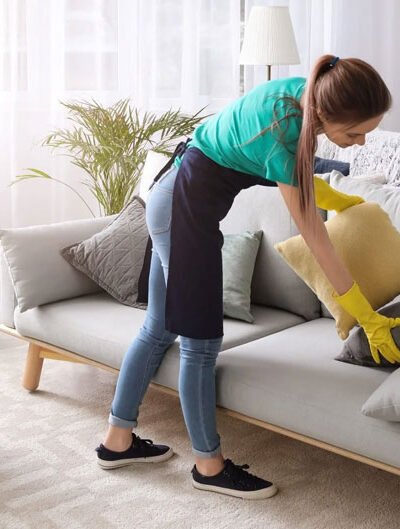 Creating a healthy, welcoming home environment is about more than just appearance. While it feels great to step into a space that looks tidy, true wellness at home comes from cleanliness that also supports health and comfort. Often, it’s the overlooked corners of cleaning, those spots and habits we don’t think twice about, that make the most significant difference.
Creating a healthy, welcoming home environment is about more than just appearance. While it feels great to step into a space that looks tidy, true wellness at home comes from cleanliness that also supports health and comfort. Often, it’s the overlooked corners of cleaning, those spots and habits we don’t think twice about, that make the most significant difference.
Why Cleanliness Impacts Wellness
A clean home doesn’t just look better, it feels better. Dust, allergens, and bacteria can settle in hidden places, silently affecting air quality and overall health. When these build up, family members may notice increased allergies, skin irritation, or even recurring illnesses. Addressing these hidden sources of grime ensures that your home is not only spotless but also supportive of well-being.
In fact, studies show that people who maintain clean living spaces report reduced stress levels and better sleep. The psychology of cleaning goes beyond the physical act; it provides a sense of control and calm, signaling to the brain that the environment is safe and balanced.
The Hidden Culprits in Everyday Cleaning
Most people clean visible surfaces, countertops, sinks, or floors, but what about the tools and spaces that often go unnoticed? Consider these areas:
- Baseboards and vents: Dust accumulates quickly and affects airflow. Wiping them down helps improve indoor air quality.
- Behind appliances: Refrigerators, ovens, and washing machines can harbor crumbs, grease, and mold.
- Curtains and blinds: These collect dust and allergens, especially in high-traffic rooms.
- Cleaning tools themselves: Sponges, cloths, and especially mops can spread bacteria if not properly cared for.
Even things like TV remotes, light switches, and reusable grocery bags can quietly carry germs if not disinfected regularly.
The Role of Cleaning Tools
Ironically, the very tools meant to keep our homes clean can sometimes be the biggest offenders. A mop, for instance, can trap dirt and bacteria, redistributing grime rather than removing it if not maintained well. That’s why knowing how to clean a mop properly is a simple but powerful step toward a healthier home. When tools are fresh and sanitized, every swipe of the floor truly clears away germs rather than layering them back on.
The same applies to vacuum filters, dish brushes, and microfiber cloths. Cleaning tools need their own care routines to remain effective.
Gentle but Effective Cleaning Practices
Harsh chemical cleaners may promise quick results, but they can also leave behind residues that irritate the skin or your respiratory system. Instead, consider:
- Vinegar and baking soda solutions for multipurpose cleaning.
- Lemon juice as a natural deodorizer and mild disinfectant.
- Eco-friendly commercial cleaners that avoid synthetic fragrances or toxins.
Another effective approach is steam cleaning. Using water heated to high temperatures, steam penetrates surfaces and kills bacteria without the need for chemicals. It’s safe for kids, pets, and anyone with sensitive skin.
Building a Seasonal Deep-Cleaning Schedule
While daily and weekly cleaning routines handle surface messes, a seasonal deep-clean ensures long-term wellness. Some areas to target include:
- Spring: Wash windows, refresh bedding, clean carpets and rugs.
- Summer: Focus on outdoor furniture, grills, and air conditioners.
- Fall: Clear gutters, dust ceiling fans, and clean fireplaces.
- Winter: Sanitize humidifiers, deep-clean kitchen appliances, and declutter storage areas.
By rotating focus areas seasonally, you’ll cover every corner of the home without overwhelming yourself.
A Routine That Sticks
Consistency is key when it comes to wellness-focused cleaning. Try incorporating small daily and weekly habits:
- Wipe high-touch surfaces (like doorknobs and light switches).
- Rotate deep-cleaning tasks, tackling blinds one week, vents the next.
- Refresh cleaning tools after each use.
- Make laundry folding, dishwashing, and tidying shared responsibilities.
A family cleaning chart or weekly checklist can help divide responsibilities fairly while keeping everyone accountable.
Creating a Restorative Environment
Beyond cleanliness, a healthier home also includes mindful organization and intentional spaces. When you minimize clutter and arrange rooms with comfort in mind, stress naturally decreases. Combined with proper cleaning, this creates a sanctuary-like atmosphere where everyone can recharge.
For example, incorporating natural light, calming colors, and houseplants adds to the sense of balance. Even small choices like diffusing essential oils or using soft fabrics can elevate comfort.
Wellness Beyond the Surface
Cleanliness also connects with wellness through air and water quality. Air purifiers, dehumidifiers, and filters help reduce allergens and mold spores. Water filters support skin health and hydration, reducing exposure to chlorine or other impurities. Even regular mattress and pillow cleaning can reduce dust mites, leading to better sleep quality.
By thinking holistically, cleanliness evolves into a complete wellness practice, not just a chore.
The Role of Community and Habits
Encouraging everyone in the household to take part creates a shared sense of responsibility. Kids can be involved in age-appropriate tasks, while adults model habits that prioritize both hygiene and sustainability. Making cleaning a collective activity helps turn it into a normal rhythm of life rather than a dreaded task.
Final Thoughts
The path to a healthier home isn’t about perfection; it’s about awareness. By paying attention to the overlooked corners of cleaning and maintaining the tools we rely on, we create a living space that supports both physical health and peace of mind. Each small, intentional step builds on the next, transforming the home into a place of lasting wellness.
Cleanliness is not just a duty, it’s an investment in quality of life. When we shift perspective from “chores” to “care,” the act of cleaning becomes a form of self-care, radiating benefits to everyone who shares the space.





Leave a Reply